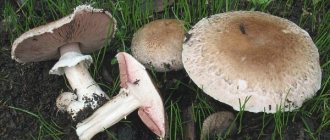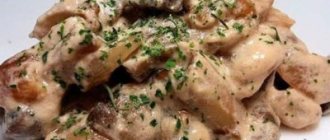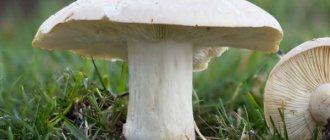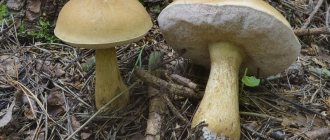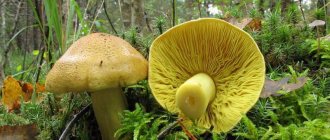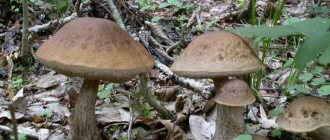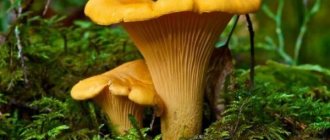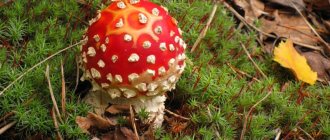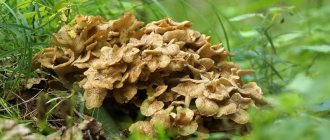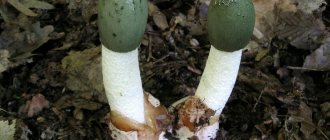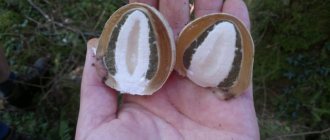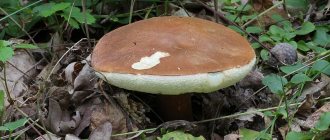At the same time, the hedgehog mushroom is a mushroom that may well lay claim to the title of the most underrated among its relatives. The thing is that many mushroom pickers are simply afraid to collect it because of the similarity of the most common species - yellow hedgehog - with toadstool. The fact that the prejudice against hedgehog mushrooms is unfounded is evidenced by the fact that these are the mushrooms that most actively store proteins for the winter.
Description
Yellow hedgehog (Hydnum repandum) has similar names such as:
- Yellow blackberry (colloquially);
- Notched hedgehog;
- Yellow hedgehog;
- Hydnum emarginate;
- The dentinum is notched.
From all these names we can conclude about its appearance: the color of the cap and the distinctive appearance of the lower part. Main differences:
Hat . It can be from 12 to 15 cm in diameter, most often has a color in shades of warm yellow, as well as light cream and red. The older the mushroom, the darker its cap becomes and acquires a nutty hue. The bright orange color can only be seen when you press on the mushroom. The hat has a configuration from convex to flat, which changes as time passes. Often there is a shape pressed in the center. Sometimes it grows together with neighboring caps due to the formation of protruding lobes. The edges are folded to the bottom. The skin is inseparable, slightly velvety.
Hymenophore or lower part of the mushroom. This is the uniqueness that will not allow it to be confused with other species. It is seeded with small thin thorns that look like needles. They reach a length of 5-7 mm and descend to the stem. The color of the spines changes with age: in young ones it is light and elastic; with age the tone becomes darker. Also, during the growth process, the spines become brittle and quickly fall off.
Controversy . They are white in color, their surface is smooth, but when viewed en masse they have a yellow tint.
Leg . Its thickness reaches 3 cm, length - up to 7 cm. The shade is yellow, quite solid, sometimes there are voids inside. It has the shape of a cylinder and rarely bends. Most often, mushrooms of this type are found with a stalk widened at the base, which smoothly turns into a cap. There are cases when it grows together with neighboring hedgehogs.
Pulp . It has a white or yellowish color. With a fairly dense structure, but with increased fragility. There is a light aroma of fruit. Over time it hardens and becomes bitter. If you press on it, it turns orange.
IMPORTANT The main advantage of the hedgehog, naturally, is that it has no poisonous analogues. Therefore, you should not be afraid that there will be a poisonous mushroom on the table.
Interesting facts about the Bloody Tooth
Some fun facts about the devil's hedgehog:
- In addition to the fact that this mushroom is very bright and beautiful, it is one of the interesting species from a biological point of view. The connection between Hydnellum and the forest environment where it grows is very tight. Scientists have discovered that the mycelium binds to the roots of trees.
- Peca is the most dangerous representative of the flora. Although the pulp does not pose any danger, a few drops of juice can kill a completely healthy person in a matter of minutes.
- The bloody mushroom often becomes an inspiration in the art world. Due to its truly killer beauty, it is often seen at photo exhibitions.
- The juice of the mushroom can be absorbed into the skin, after which it cannot be completely removed from the body. After a quiet hunt, many mushroom pickers felt a noticeable deterioration in their health, so experts strongly advise against even touching it.
- Hydnellum is spreading throughout the world according to an unknown pattern. If a hundred years ago it could only be found in North America, then already in the 21st century it was seen in Iran and China.
- According to the research results, it was revealed that mycelium can spread within a radius of 3 meters. This is a very high indicator among mushrooms, since the average distribution distance is no more than 1 meter.
Today, in order to find the devil's hedgehog, scientists use modern technologies that, by cultivating the soil, can find the DNA of the fungus. Since even if the bodies themselves cannot be visually detected, this does not mean that they do not exist at all. Mycelium can be stored in soil for years.
Where and when to collect?
Hydnum notmata grows in European, North American, Siberian and Far Eastern forests. Prefers sandy soil in dry coniferous forests, but there are species that grow in limestone.
Most often you can find them alone, but you can also come across whole mushroom rings. There are species that can grow on stumps, dead wood or substrates, as well as in tree hollows.
Mushrooms grow from June until the onset of frost, but the highest growth is observed at the end of August and early September.
Beneficial properties of yellow hedgehogs
Blackberries are not only used as food; thanks to their unique composition, they have been used in folk medicine for a long time.
If you often eat yellow hedgehogs, it will help strengthen the body and renew the blood. These mushrooms are used to make healing ointments that are used to treat skin diseases. They are often used to make cosmetic masks that have a high regenerating effect, tone and nourish the skin.
Similar species
A similar species is the reddish-yellow hedgehog. These mushrooms are very similar to each other, their difference lies only in the smaller size of the reddish-yellow cap and the red tint of the cap. But most often the yellow hedgehog is confused with the common chanterelle.
Benefits and use of Blackberry notched in medicine
The pulp of the hedgehog contains beneficial properties that can:
- inhibit bacteria and even such as staphylococcus;
- perfectly stimulates the immune system;
- normalize the functioning of the endocrine glands;
- help blood renewal and hematopoiesis;
- raise tone;
- can improve the general condition of the skin.
REFERENCE Ointment with the addition of this mushroom is used not only for medicinal, but also for cosmetic purposes for masks.
These medicinal mushrooms contain fatty acids, phenols, and polysaccharides. All these medicinal substances affect cancer cells - they destroy them in the same way as chemotherapy.
The tumor resolves, decreases in size, and sometimes disappears altogether. To combat viruses and infections, extracts from hedgehogs are used. There are also ointments for burns based on it.
INTERESTING For example, in China, hedgehog tincture is used in cases of long-term depression.
Compound
Has a wide range of vitamins:
- Riboflavin;
- Vitamin C;
- Vitamin PP;
- Betaine;
- Pantothenic acid;
- Vitamin D;
- Vitamin B4;
- Ergocalciferol (Vitamin D2);
- Dihydrophylloquinone (Vitamin K1).
Macro- and microelements:
- Potassium;
- Sodium;
- Phosphorus;
- Calcium;
- Magnesium;
- Selenium.
Amino acids:
- 2,6-diaminohexanoic acid;
- Glutamic acid;
- 2-aminopropanoic acid;
- Leucine;
- 2-amino-3-methylbutanoic acid;
- Aminosuccinic acid.
After heat treatment, the beneficial substances in them are preserved almost in full.
Use in cooking
This type of mushroom has very good taste. The pulp has a sweetish taste and an unobtrusive nutty smell. It also contains a slight sourness. There are countries that dry and grind mushrooms, and then make seasonings out of it, adding them to first and second courses.
Types of mushrooms
It is noteworthy that the name “hedgehog” unites at least ten separate species of mushrooms, often endowed with very distant external similarities. However, they have one common characteristic - the hymenophore (lower surface of the cap) in the form of small spines. It is partly because of them that mushroom pickers don’t like hedgehogs so much: the whole point is that the outgrowths of the hymenophore are very fragile, they quickly come off, dirtying the rest of the “catch”.
Content:
- Types of mushrooms
- Yellow hedgehog - general characteristics
- Composition and calorie content
- Beneficial features
- Harm and contraindications
- Taste and use in cooking
So, representatives of several families are called hedgehogs: hedgehogs (yellow and reddish hedgehogs), bankeraceae (black, felt, variegated and rough hedgehogs), hericiaceae (coral, combed and antennal hedgehogs), exidiaceae (jelly-shaped hedgehogs).
It is noteworthy that, although representatives of almost all of the listed species theoretically grow on the territory of Russia, you may not even expect to meet some of them in the forest. Many hedgehog mushrooms are not just rare, but listed in the Red Book. Therefore, it does not make much sense to describe them in detail, but instead it is better to closely study the most common edible mushroom from this group - the yellow hedgehog.
Growing at home and in the country
Interestingly, this type of mushroom can be grown both at home and in a summer cottage. It is sown in open ground starting in mid-spring and ending until mid-autumn. For sowing, ready-made mycelium is used (sold in sticks that are infected with fungal spores).
In some types, wood may be used instead of soil. Coniferous, deciduous trees, and fresh branches are used as it. The wood is filled with water for several days, after which it is removed and all the water is allowed to drain. Next, insert mushroom sticks into the holes.
Then the tree is wrapped in film and cuts are made to allow oxygen to enter. It is stored in a dark, warm room. Watering occurs twice a week. When the mycelium appears, the wood should be placed in water for 24 hours, then placed vertically in a bright place.
IMPORTANT In winter, the mycelium needs to be insulated, covered with leaves or stored in the cellar.
The first harvest should be expected approximately six months after sowing.
Plant care
Landing
The bulbs must be strong and undamaged. If they have dried out a little, then before planting they are soaked in water for several hours.
REFERENCE! Biostimulants (Epin, Zircon) can be added to the water. These drugs promote the formation of a healthy root system, protect the bulb from fungi and bacteria, and they are growth stimulants.
Planting is a stressful situation for the bulb, which is in a dormant state, and the drugs help the plant enter the growth phase.
The bulbs are planted to a depth of 25 centimeters. In any case, the depth of the hole should be three times the diameter of the bulb. The smaller the bulb, the shallower the depth of the hole. For the smallest onions, the planting depth is 10 centimeters. Soil acidity can be neutral or slightly alkaline.
IMPORTANT! Rain and irrigation water should not stagnate at the root system, and at the same time the root system should not suffer from its lack
Transfer
Therefore, a large lump of earth with a bulb inside is pulled out of the soil and carefully transferred to a deep, pre-prepared hole. The lump is covered with soil, lightly compacted so that the plant does not tilt to its side, and watered thoroughly.
INTERESTING! The bulbs of both garden and wild Saranka are edible. They contain starch and can be eaten boiled or fried. In folk medicine, the juice of the plant is used as a wound-healing agent, and an infusion of tubers is used as an analgesic and anti-inflammatory agent.
Temperature
Kudrevataya winters well not only in central Russia, but also in Siberia and the Far East. Most varieties do not freeze even in severe winters.
During the summer, temperatures in these regions are usually optimal for growth and flowering.
Growing
During the growing season, curly lily does not require special care. In dry weather, you need to water the flowers regularly; during rains, you should monitor the degree of soil moisture. During prolonged rains, waterlogging of the soil can be avoided by stretching plastic film or an awning over the flowers.
After flowering, seed pods form on the stems. It is not recommended to break them off, as infection and fungus can enter the root system through broken stems.
For the winter, the beds are covered with fallen leaves and grass. Lilies will survive the winter well if there is no water standing in the soil for a long time during thaws.
IMPORTANT! In dry weather, if the plant does not have enough water, leaf growth stops and they may begin to dry out. During this period, preparations are added to the irrigation water to stimulate the strengthening and growth of roots.
These can be Kornerost, Ukorenit, Zircon.
Reproduction
Locusts are most often propagated by scaling. To do this in the fall, without digging up the bulb, three or four outer scales are separated from it.
The vessel is stored at room temperature. After a couple of months, small bulbs appear on the scales. After their appearance, the scales are transferred to a cool room, underground or cellar. They will remain there until spring.
If by this time the scales have not fallen off, then plant them in the soil directly with them. Rotten scales are cut off and the cut is moistened with Bordeaux mixture.
REFERENCE! A full-fledged flower develops from a bulb after 4-7 years.
Bloom
In central Russia it blooms depending on weather conditions, in late June - early July. In Siberia, flowering begins in mid-July. The flowers open together, starting from the bottom of the stem and ending with the top. After flowering, small green boxes remain on the stems, which, as they dry, take on a hexagonal shape.
Petals can be lilac, violet, crimson, orange; subspecies with dazzling white petals are also known.
Fertilizers
It needs to be fed several times during the growing season. In spring, mineral fertilizers containing nitrogen are applied to the soil. When the buds appear, the plants are fed with fertilizers containing phosphorus. After flowering, when the Lily has spent a lot of energy on the formation of numerous flowers, fertilizers are added to the soil again.
REFERENCE!
Nitrogen fertilizers - ammonium sulfate, ammonium nitrate, sodium and calcium nitrate. Phosphorus fertilizer - superphosphate. Potash fertilizers - wood ash, potassium sulfate, potassium salt, potassium chloride.
Complex fertilizers specifically for flowers are also produced, containing several chemical elements.
Inedible specimens
The blackberry mushroom has two inedible varieties. They are not very similar, but many still confuse them. Let's look at the distinctive features in the table.
| Name | Characteristic |
| Diabolical |
|
| Black | The second name is Phellodon black.
|
Pickling
In Mexico, it is pickled in pepper and actively sold in bazaars, but this “double” effect can lead to severe poisoning in an unprepared body.
Regular soaking will also help improve the taste and avoid poisoning. The gall is cut crosswise into two parts and placed in a bath of warm water. The mushroom should be soaked for 2–3 days, changing the water periodically. After this, you can safely pickle it and pickle it for the winter; there will be no bitterness or indigestion. You can eat it alone or with your favorite dishes.
To increase the shelf life of the collected mushroom, you need to wrap it in paper and place it in the refrigerator.
